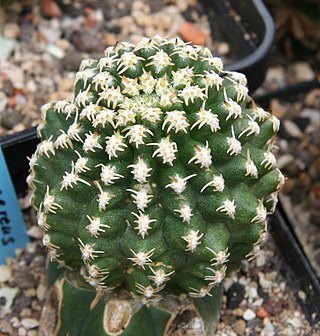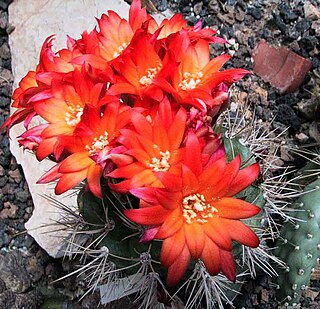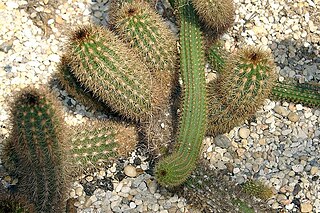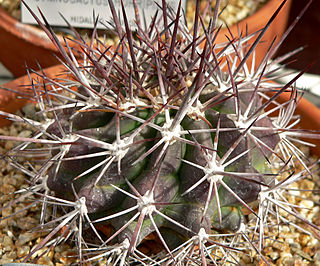
Yavia cryptocarpa is a species of cactus and the only species of the newly discovered genus Yavia. The genus is named after Argentina's department Yavi, Jujuy Province, where the plant is endemic to sparsely vegetated rocky slopes. The plant is also sometimes put in the tribe Notocacteae. The specific epithet cryptocarpa refers to the plant being a cryptocarp. This means that the fruits are formed inside the plant's body, thus being only visible when the plant shrinks in the drought period.

Arthrocereus melanurus is a species of plant in the family Cactaceae. It is endemic to Brazil. Its natural habitats are dry savanna and rocky areas. It is threatened largely by habitat loss.

Haageocereus bieblii is a species of Haageocereus from Peru.

Oreocereus trollii, commonly known as the Old Man of the Andes cactus, is a species of cacti native to Argentina and Bolivia. Though listed as Least Concern by the IUCN, the plant is collected extensively, and in some areas is threatened.

Echinopsis densispina, is a species of Echinopsis found in Argentina.

Haageocereus pseudomelanostele is a species of Haageocereus found in Peru.

Matucana weberbaueri is a species of Matucana found in Peru.

Matucana oreodoxa is a species of Matucana found in Peru.

Weberbauerocereus albus is a species of Weberbauerocereus from Peru.

Weberbauerocereus winterianus is a species of Weberbauerocereus from Peru.

Haageocereus versicolor is a species of Haageocereus found in Peru.

Haageocereus acranthus is a species of Haageocereus found in Peru.

Oroya peruviana is a species of cacti, originating from Peru.

Oreocereus ritteri is a species of Oreocereus found in Peru.

Loxanthocereus xylorhizus is a species of Loxanthocereus found in Peru.
Weberbauerocereus churinensis is a species of cactus in the genus Weberbauerocereus, native to Peru.

Ferocactus lindsayi is a species of Ferocactus found in Mexico.

Cochemiea blossfeldiana is a species of Cochemiea found in Mexico.

Cochemiea saboae is a species of Cochemiea found in Mexico.

Echinocereus viereckii is a species of cactus native to Mexico.
























